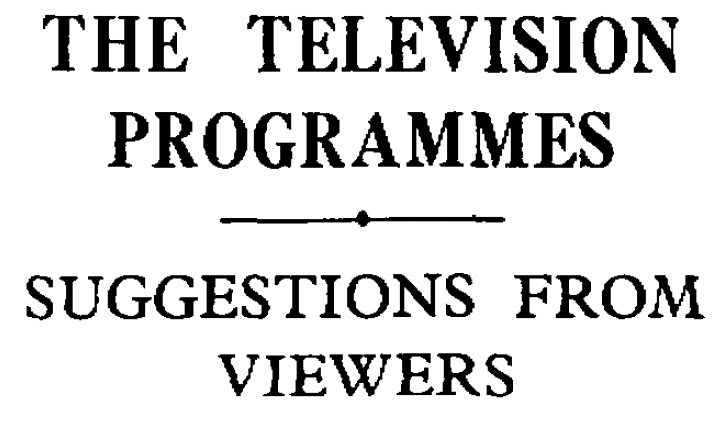OTD in early British television: 12 February 1939

John Wyver writes: The afternoon schedule on Sunday 12 February 1939 began with two caption cards accompanied by Bing Crosby (on record) singing ‘Please’ and, I assume, some words from on-duty announcer Elizabeth Cowell. That morning’s Sunday Times explained the context for the request made to viewers:
During this afternoon’s television transmission from Alexandra Palace it will be announced that a complete census of television viewers, with an analysis of their preferences in programmes, is to be made.
This was AP’s second attempt to discover, in an age when audience research was in its infancy and had not yet been extended to television, what lookers-in thought about the service. The first, right at the start of 1937, had prompted 74 detailed responses. Now pressure from the Radio Manufacturers’ Association to stimulate sales with more popular programmes led to a further attempt.
As the Sunday Times further noted:
It is felt that television has reached a stage of stability, and that viewers can now give considered opinions on the merits of different types of broadcasts.
Viewers were asked to write in to request a detailed questionnaire, and more than 4,000 of these were eventually received. A detailed analysis of the returns was eventually issued in June (and we may well get to that later in the year), but the on-air prompt had spillover effects too.
The following Sunday, The Observer reported (under the headline pictured above):
The response has been much beyond expectations. Letters, postcards, and the filled-in questionnaire have been arriving at a rate of over a thousand a day. Many viewers have not waited for the questions, but have sent long letters explaining why they think that television is the finest form of home entertainment yet invented.
Mr Gerald Cock, Director of Television, tells me that they have been overwhelmed in a way they certainly did not expect. More than ninety-eight per cent of the letters and answers received are most enthusiastic. He has been agreeably surprised, too, to find how many receivers have been acquired since Christmas. Sales are still going up.
Cock was quoted as saying that one of the main requests was for a Children’s Hour at least once a week, and that this was something that the service would introduce in the summer — as in a somewhat tentative form, it did. He also noted the desire on the part of many for afternoon programmes to begin later, at 4pm rather than 3pm, and the evening schedule to start earlier, ideally at 8.30pm.
Accommodating this, of course, would have a major impact on the logistics at AP, and especially the time available for studio rehearsals, with evening programmes often only able to have run through with cameras in the downtime between 4.30 or so and 9pm. Cock was nonetheless positive about the possibilities:
Difficulties worse than that have been abolished in our two and a half years of running. We shall find some way of giving viewers what they want.
The September 1 shutdown intervened before any such scheduling changes could be made, and when the service returned in June 1946, the programme blocks again began at 3pm and 9pm.
Leave a Reply